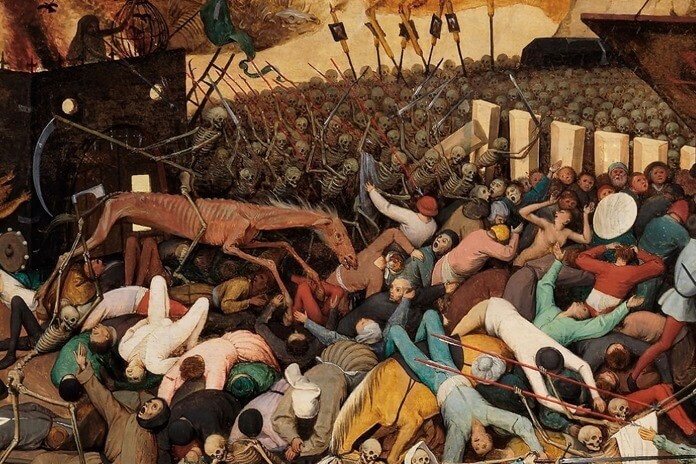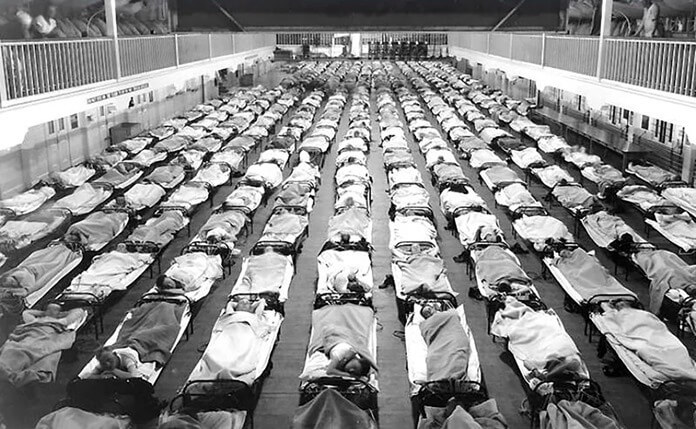During an outbreak of an infectious disease, there is no worse case scenario than a pandemic. This is the name of a situation in which the epidemic spreads outside the country.
The more civilized people began to build cities, pave trade routes and wage wars with other cities, the more likely pandemics became. Below is a list of the worst pandemics in world history.
10. Plague of Athens - 430 BC
 The exact number of victims is unknown, only in Athens - 30 thousand people.
The exact number of victims is unknown, only in Athens - 30 thousand people.
The earliest recorded pandemic occurred during the Peloponnesian War. After the disease passed through Libya, Ethiopia and Egypt, it overcame the Athenian walls, which were besieged by the Spartans. Because of her, two-thirds of the population of Athens died.
Symptoms of the Athenian plague included fever, thirst, bloody sore throat and tongue, and redness of the skin. The disease, presumably typhoid fever, greatly weakened the Athenians and contributed to the victory of the Spartans.
9. Plague of Justinian - 541 AD
 The number of victims is 25 million in Europe and 66 million in the East.
The number of victims is 25 million in Europe and 66 million in the East.
One of the worst diseases in human history appeared first in Egypt, then spread throughout Palestine and Byzantium, and then throughout the Mediterranean.
This plague is credited with creating the apocalyptic atmosphere that spurred the rapid spread of Christianity.
It is believed that the Justinian plague is the first large-scale appearance of the bubonic plague. She did not spare either the powerful, or even the holy people, among whom was the founder of Irish monasticism, Saint Finnian of Clonard.
8. Leprosy (leprosy) - Middle Ages
 The exact number of victims is unknown.
The exact number of victims is unknown.
Although leprosy was known in the time of Hippocrates and is mentioned in the Bible, it acquired the status of a pandemic in the Middle Ages in Europe. As a result of the widespread spread of the disease, more than 19,000 leper colony were built - institutions focused on the maintenance of patients with leprosy.
This slowly developing bacterial disease, which causes wounds and deformities, was considered divine punishment, which only further averted healthy people from leprosy victims. They were often expelled from the settlements, and ritually buried during their lifetime.
Leprosy is currently being successfully treated with antimicrobial therapy. In the 21st century, there are less than 500 thousand leprosy patients on Earth, most of whom live in Indonesia, India and Brazil.
7. Black Death - 1346-1353
 The death toll is 75-200 million.
The death toll is 75-200 million.
The second major outbreak of bubonic plague in history may have started in Asia and traveled west with traders. In 1347 AD, when plague patients arrived at the Sicilian port of Messina, the disease quickly spread throughout Europe. There were so many dead that many corpses remained to rot on the ground and created a constant stench in the cities.
England and France were so incapacitated by the plague that they declared a truce in the Hundred Years War.The British feudal system collapsed when the Black Death changed the economic circumstances and demographics of all of Europe.
6. Smallpox - 1520
 The total number of deaths is unknown.
The total number of deaths is unknown.
For centuries, smallpox has been one of the main disease-causing threats to the populations of Europe, Asia and Arabia. She claimed the lives of every 3 in 10 infected people. And the first European researchers brought the smallpox virus to the New World, whose inhabitants did not have immunity from this disease.
It was smallpox that was one of the main reasons for the death of the Aztec empire. And in the Americas, smallpox took about 100 years to wipe out about 90 percent of the indigenous population. Mexico's population declined to one million from 11 million before European conquest
Research in 2019 concluded that the deaths of about 56 million Native Americans in the 16th and 17th centuries, mainly due to smallpox and other diseases, could have changed the Earth's climate. Vegetation growth on previously cultivated land pulled more CO2 out of the atmosphere and caused a cooling.
Fun fact: Smallpox was the first viral epidemic to be stopped by a vaccine. In 1980, the World Health Organization announced that smallpox had been eradicated worldwide.
5. The first cholera pandemic - 1817.
 It is believed to have claimed the lives of several million people.
It is believed to have claimed the lives of several million people.
Until the 19th century, cholera was confined to the borders of India. And even the active colonial policy of Britain, migration of people and the growth of international trade are unable to explain the explosive nature of the spread of cholera throughout the world. It is believed that the disease causing bacteria mutated due to abnormal weather conditions in 1816.
Spreading through food and water contaminated with feces, Vibrio cholerae were passed on to British soldiers who brought them from India to Spain, Africa, Indonesia, China, Japan, Italy, Germany and America, where a total of 150,000 people died.
The pandemic also affected the Russian Empire, where, according to official figures, a little more than 197 thousand people died. Cholera, nicknamed "the death of a dog" by Russians, has led to previously unheard-of restrictions on movement, leading to cholera riots.
In St. Petersburg, crowds of mortally frightened people were caught and beaten half to death by foreign doctors, who were accused of having brought the infection to Russia in order to exterminate the Russian people. It took the intervention of the police and the military to stop such popular atrocities.
The vaccine was created in 1885, but cholera pandemics continued until 1975.
4. The third plague pandemic - 1855
 The bubonic plague claimed 15 million lives.
The bubonic plague claimed 15 million lives.
Starting in the Chinese province of Yunnan and moving to India and Hong Kong, the bubonic plague reaped its dark harvest for the third time.
India suffered the most significant losses, and the epidemic of a terrible disease in this country was used as an excuse for the repressive policies of England, which sparked an uprising against the British. In the literature, it is known as the First War of Independence or the "Rise of the Sepoy".
One of the worst pandemics in the world was considered active until 1960, when the number of cases fell below a couple hundred.
3. Spanish flu - 1918
 The total number of victims is 50 million.
The total number of victims is 50 million.
The largest influenza pandemic in history first raged in Europe, the United States and parts of Asia, and then quickly spread around the world.
At the time, there were no effective drugs or vaccines to treat this strain of influenza virus. Reports of an outbreak of influenza in Madrid in the spring of 1918 led to the pandemic being called "Spanish flu" or, more shortly, "Spanish flu".
In Russia, 3 million people, or 3.4% of the country's population, died from the Spanish flu.
The threat of the Spanish flu did not disappear until the summer of 1919, when most of those infected either recovered or died.
2. HIV / AIDS - 1981
 Already 35 million people with AIDS have died since its discovery in 1981.
Already 35 million people with AIDS have died since its discovery in 1981.
“Nobody dies of AIDS,” the reader might argue.Indeed, AIDS itself, aka acquired immune deficiency syndrome caused by the human immunodeficiency virus (HIV), does not kill anyone.
They kill oncological and other diseases that arise in a person due to the fact that AIDS destroyed the immune system, and the body was unable to fight the infection that entered it.
An interesting fact: originally, the disease caused by HIV was called "four G disease" because it was found in:
- Haitians or visitors to the island;
- homosexuals;
- heroin addicts;
- hemophilicists.
However, later doctors found out that AIDS occurs not only in persons practicing homosexual relationships. Therefore, in 1982, the term AIDS was introduced into circulation, which remains relevant to this day.
1. Wuhan coronavirus - 2019
 As of April 15, 2020, 129,976 dead.
As of April 15, 2020, 129,976 dead.
You and I live in interesting times and are even direct spectators and participants in how coronavirus is changing the world.
COVID-19 is caused by a new 2019-nCoV strain that has not previously been detected in humans. Symptoms, including breathing problems, fever, and a debilitating dry cough, can lead to pneumonia and death. In the "red" risk zone for coronavirus there are elderly people.
Since a vaccine has not yet been created for the new virus, it has spread beyond China, and by mid-April was recorded in 183 countries around the world. Currently, the coronavirus is, if not the worst pandemic in the world, then at least the most publicized.
In terms of the number of infected, the United States is leading, where there are already 607 670 cases, Russia (24 490 cases of the disease) is in 15th place.

